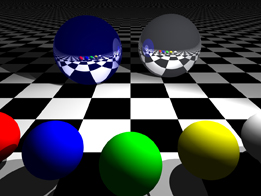Module 7 Summary
| Site: | MoodleHUB.ca 🍁 |
| Course: | Math 20-1 SS |
| Book: | Module 7 Summary |
| Printed by: | Guest user |
| Date: | Thursday, 4 December 2025, 2:08 AM |
Description
Created by IMSreader
1. Module 7 Summary
Module 7 Summary

The image (at right) shows a computer-generated graphic rendered in Google SketchUp. In the crystal orbs you can see reflections of the room behind the row of coloured balls. What is the colour of the other orb in the room? What aspects of the image suggest that it is computer generated? What mathematic's principles do you suppose were involved in the program that was used to generate the image?
Just as math is the language used to describe the physical world, it is equally useful when describing art. Properties such as symmetry, texture, shade, and value can all be quantified and measured. In this module you explored function art, which allowed you to create images that could be described by functions, including absolute value and reciprocal functions.
In this module you investigated the following questions:
- How are the properties of absolute value functions and reciprocal functions related to their graphs?
- How can mathematics be used to create art?
In this module you investigated the properties of absolute value functions and reciprocal functions. You learned how to express absolute value functions in piecewise notation. You learned that the graphs of absolute value functions are found on or above the x-axis. This is because the result of an absolute value expression is positive, or at the least, zero. You also solved absolute value equations based on the notion that the expression within the absolute value symbol could either be positive or negative. It is possible, however, that a calculated root of an absolute value equation is extraneous. Therefore, it is imperative that each root is verified.
In the last lesson of this module you explored reciprocal functions. You discovered how the properties of reciprocals translate into the properties of the graphs of reciprocal functions. These discoveries led to strategies for graphing these functions.
Throughout this module you made connections between mathematics and art. You learned that mathematics can be used to value, create, and assess art. You looked at some famous works by both artists and mathematicians. You saw multiple ways of using mathematics to generate art. One of those ways was realized in the creation of your project, in which you created a drawing based on the graphs of functions you studied in this module and in this course.
Module 7: Absolute Value and Reciprocal Functions Video Summary is a look back at the math you explored. Watch the video summary to review what you learned and to confirm your answers to the module questions.
The following table summarizes the learning outcomes in Module 7. As a review of what you have learned, complete the table by identifying the activities you undertook to address the corresponding outcomes.
You can also use the navigation tree to revisit those lessons that you don’t remember well.
![]() Save a copy of your completed table in your course folder for review.
Save a copy of your completed table in your course folder for review.
| Outcomes for This Module | Learning Activities in Which I Addressed This Outcome |
| Graph and analyze absolute value functions to solve problems. | |
| Graph and analyze reciprocal functions. |
